Celebrity Sudoku (24 page)
Authors: Kaye Morgan

“Mrs. H. already agreed to take care of Rusty for the duration,” Liza assured him. “As for the job—” She smiled. “I can telecommute.”
“That only leaves one thing,” Michael finally said.
“What’s that?”
“I only have one arm working, and I need to scratch. Are you ever going to let go of my hand?”
Liza smiled. “I don’t think so.”
It was like the first rule of sudoku: “If at first you screw things up, try, try again.”
Maybe, together, this time around they could solve the biggest puzzle of all.
Sudo-cues
Out of Symmetry
Written by Oregon’s own leading sudoku columnist, Liza K
My husband started out as an agnostic—but I’m afraid now he’s become a heretic. He didn’t much care if his sudoku puzzles came in symmetrical or non-symmetrical patterns. Lately, however, he’s come down pretty heavily on the non-symmetrical side. The symmetrical/non-symmetrical argument has threatened Sudoku Nation with civil war for years. Let’s just hope we can keep things civil over the breakfast table.
So where did this whole controversy come from?
The notion of creating arrays of numbers with each number appearing only once in the rows and columns has probably been a mathematical pastime for centuries. The creation of Latin squares, as they were known, was certainly popularized by an eighteenth-century mathematician, Leonhard Euler. These were not puzzles with clues, however—it was more like presenting sudoku solutions. And they also lacked the additional constraint of subgrids where numbers could not recur.
It wasn’t until 1979 that a puzzle called “number place” with the restrictions on columns, rows, and subgrids appeared—not in Japan, but in an American puzzle magazine. Although it was uncredited, it is believed to be the work of puzzle constructor Howard Garns.
By the way, it wasn’t symmetrical.
These number place puzzles appeared for several years. By the mid-1980s the form was picked up by a Japanese publisher of puzzle magazines, Nikoli. They were called sudoku—short for
“sūji wa dokushin ni kagiru.”
That’s Japanese for “the numbers must be single”—or occur only once. Incidentally, the
“dokushin”
part of the name also means “single” in the sense of “unmarried” or “celibate.” So it seems our favorite puzzle with its naked pairs and hidden singles had a double entendre from its early beginnings.
“sūji wa dokushin ni kagiru.”
That’s Japanese for “the numbers must be single”—or occur only once. Incidentally, the
“dokushin”
part of the name also means “single” in the sense of “unmarried” or “celibate.” So it seems our favorite puzzle with its naked pairs and hidden singles had a double entendre from its early beginnings.
The puzzle people at Nikoli may not have cleaned up the terminology, but they did refine the puzzles, reducing the number of clues and arranging them in symmetrical patterns. It’s been suggested that the symmetry notion may have come from crosswords, where the professionally constructed varieties show the same pattern whether the puzzle is viewed right side up or upside down. Although the Japanese love puzzles, their writing system is not crossword-friendly.
It took almost another twenty years before sudoku made its way back into the English-speaking world, mainly thanks to a judge from New Zealand named Wayne Gould. He encountered the puzzle in Tokyo in 1997, became addicted, created a computer program to construct sudoku, and proselytized the puzzle until it was picked up by the
London Times
in 2004. After conquering Britain, sudoku hopped the Atlantic back to America, essentially circumnavigating the globe in about a quarter of a century—and picking up an estimated eighty million fans in some seventy countries along the way.
London Times
in 2004. After conquering Britain, sudoku hopped the Atlantic back to America, essentially circumnavigating the globe in about a quarter of a century—and picking up an estimated eighty million fans in some seventy countries along the way.
So what is this whole symmetry thing? It means that sudoku puzzles can repeat the pattern of clues either through mirror reflection or by rotating part of the patterns.
The following seven sudoku blanks show reflective symmetry—if you put a mirror on the dotted line, it would show the same pattern that appears on the other half of the puzzle.
Horizontal and vertical reflections show a mirror image from left to right or from top to bottom.

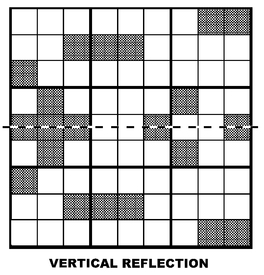
Diagonal reflection cuts the puzzle in half from upper left to lower right, with the pattern mirrored above and to the right. Anti-diagonal symmetry cuts the puzzle from upper right to lower left, with the pattern recurring in the lower right-hand side.
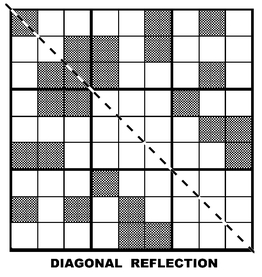
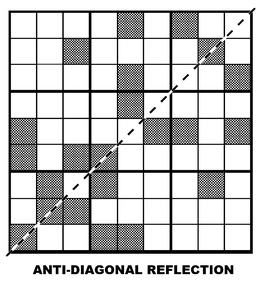
Symmetry can also combine one axis with another, resulting in puzzles that are simultaneously symmetrical both in the horizontal and vertical directions, or the diagonal and anti-diagonal.
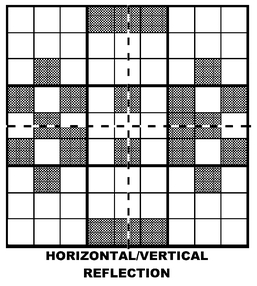
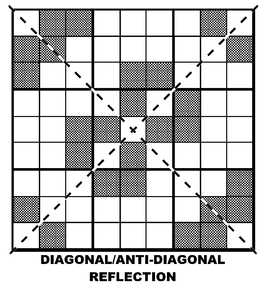
Finally, there’s one form that is symmetrical from all viewpoints—side-to-side, top-to-bottom, diagonally, and anti-diagonally. This is called “full dihedral reflection,” and I have to admit it’s one of my favorites. Sudoku puzzles with this symmetry always remind me of snowflakes (which are, in fact, natural examples of dihedral symmetry).
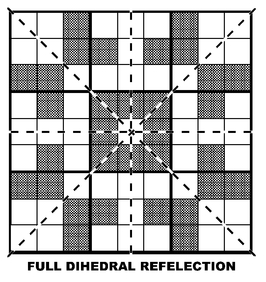
Pretty as reflective symmetry is, you don’t see all that many mirror-image puzzles in sudoku. The vast majority, like crosswords, use rotational symmetry to create a pattern of clues. Essentially, this symmetry is created by spinning around or rotating part of an existing image. For instance, if you take half the puzzle and spin it around to the bottom, you end up with 180-degree rotation, as shown below.
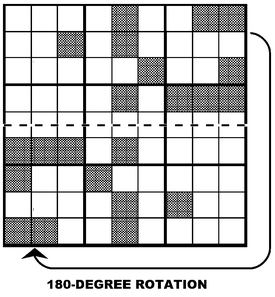
You can also take a quarter of the puzzle and give it a quarter turn through each remaining quadrant of the puzzle matrix, resulting in a 90-degree rotation. This is another design I particularly like—the results often end up looking like pinwheels.

Other books
Indecision by Benjamin Kunkel
Crash and Burn by Lange, Artie
The Woman Warrior: Memoirs of a Girlhood Among Ghosts by Maxine Hong Kingston
It's in His Kiss by Caitie Quinn
El complejo de Di by Dai Sijie
The Tracker's Quest: (Forced To Serve #6) by Donna McDonald
Redemption (Iris Series) by Lynn, Rebecca
Early Irish Myths and Sagas by Jeffrey Gantz
Honeymoon in Paris by Juliette Sobanet
Lizard Tales by Ron Shirley